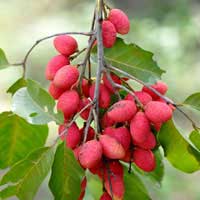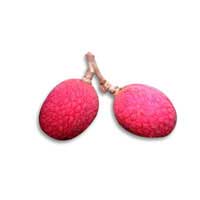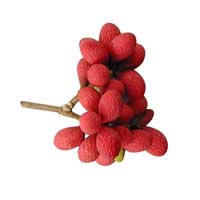 Full List of Fruits
Full List of Fruits  Korlan fruit
Korlan fruitKorlan fruit
Scientific name - Nephelium hypoleucum
Korlan is from the family of Sapindaceae that's native of South East Asia. Found growing wild in most of the South Eastern Asian countries, they are also planted in Thailand and Malaysia. Having a close association to several other tropical fruits, they share the same features and characteristics of lychee, longan, rambutan, and mamoncillo. The fruit of Korlan is best described as a cross between and rambutan, generally known as wild lychee. Put up with a loose pendant cluster, the fruit is oval to round in shape. This evergreen tree grows upto 30 m tall with a trunk size of 1.40 m in diameter, with buttress upto 1.5 m tall.
 Leaves, 1-5-jugate
Leaves, 1-5-jugate
 petiole 3-16 mm cm long
petiole 3-16 mm cm long
 petiolules 5-11 mm
petiolules 5-11 mm
 leaflets 6.5-30 cmx2-8 cm 2-4.5 times as long as wide
leaflets 6.5-30 cmx2-8 cm 2-4.5 times as long as wide
![]() Health Benefits of Korlan fruit
Health Benefits of Korlan fruit
Korlan- the rare wild fruit juice has a delicious and unique taste of sour and sweet variety with health benefits from vitamins and antioxidants. Following are some of the list of benefits:
 Regulates blood sugar
Regulates blood sugar
 Improves concentration in ADHD patients
Improves concentration in ADHD patients
 Reduce stress : Taken as a daily stimulant for energy boost, they improve your immune system and reduce stress to a great extent.
Reduce stress : Taken as a daily stimulant for energy boost, they improve your immune system and reduce stress to a great extent.
 Combat flu viruses and cold: The finding of a study that has been conducted recently says that it helps to combat cold, flu viruses and even herpes infections. Small doses, with less quantity, it is said to help reduce the severity of virus and cold infections. Despite, there is no scientific proof to these studies, level of antibodies to thwart infections do go up while an individual is considering to intake extracts.
Combat flu viruses and cold: The finding of a study that has been conducted recently says that it helps to combat cold, flu viruses and even herpes infections. Small doses, with less quantity, it is said to help reduce the severity of virus and cold infections. Despite, there is no scientific proof to these studies, level of antibodies to thwart infections do go up while an individual is considering to intake extracts.
 Aids in digestion:
The wild roots of Korlan have been used by the Korean herbalist for quite some years to calm a person's spirit, help in digestion and have stronger lungs, while giving the patient extra energy.
Aids in digestion:
The wild roots of Korlan have been used by the Korean herbalist for quite some years to calm a person's spirit, help in digestion and have stronger lungs, while giving the patient extra energy.
With the help of air layering, asexual propagation can be done and new plants of Nephelium hypoleucum can be nurtured from seed.
In Vietnam, N. hypoleucum occurs in the wild, especially in mountainous areas in southern Vietnam such as Tay Ninh or An Giang provinces. Unlike lychee or rambutan trees, the korlan trees are not commercially cultivated. Wild korlan fruits are gathered and sold in small quantities.
Korlan fruits are sour, with a little sweet aftertaste. In Vietnam, they can be eaten as is, or with a condiment of salt and chili pepper as a rustic fruit snack. Another condiment is fish sauce with sugar: In a bowl of fish sauce, add sugar to get dissolved, and then add the peeled korlan fruits into the bowl.
New plants of korlan can be raised from seed. Asexual propagation can be done by air layering.



















